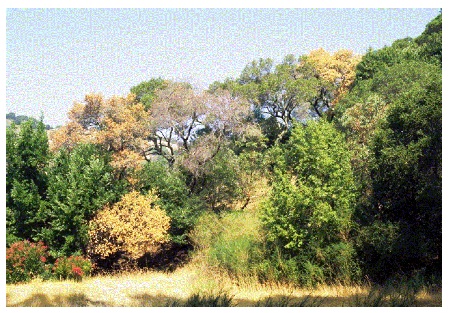PESTS AND DISEASES OF FORESTRY IN NEW ZEALAND
Sudden oak death in California, 2001
Scion is the leading provider of forest-related knowledge in New Zealand
Formerly known as the Forest Research Institute, Scion has been a leader in research relating to forest health for over 50 years. The Rotorua-based Crown Research Institute continues to provide science that will protect all forests from damage caused by insect pests, pathogens and weeds. The information presented below arises from these research activities.
From Forest Health News 113, November 2001.
Californians are reeling under another threat to their native trees. The new problem eclipses even pine pitch canker disease caused by Fusarium circinatum which has devastated radiata pine in coastal California, and is regarded as a major threat to plantations of this species world-wide (FHNews 111:1). Native oaks and other trees have been dying in tens of thousands in California since 1995. The causal agent is a new species of Phytophthora called Phytophthora ramorum. This fungus also occurs in Europe on species of Rhododendron and Viburnum, on which it causes only limited damage. Phytophthora ramorum appears to have been carried from Europe to California on ornamental rhododendrons.
 Trees killed in California include tanoak (Lithocarpus densiflorus), a number of red oaks such as Quercus agrifolia, Q. kellogii and Q. parvula var. shrevei, and Pacific madrone (Arbutus menziesii ). However, some oaks, for example blue oak ( Q. douglassii ) and valley oak (Q. lobata ), are not susceptible. Phytophthora ramorum also attacks natural understorey plants, such as bay laurel (Umbellularia californica), huckleberry (Vaccinium ovatum ), and rhododendrons. These hosts suffer only leaf spotting and twig dieback, but act as a reservoir of inoculum in woodlands and forests. The full impact of the disease is still unknown but an intensive research effort has been initiated with funds of US $7 million provided by both state and federal agencies.
Trees killed in California include tanoak (Lithocarpus densiflorus), a number of red oaks such as Quercus agrifolia, Q. kellogii and Q. parvula var. shrevei, and Pacific madrone (Arbutus menziesii ). However, some oaks, for example blue oak ( Q. douglassii ) and valley oak (Q. lobata ), are not susceptible. Phytophthora ramorum also attacks natural understorey plants, such as bay laurel (Umbellularia californica), huckleberry (Vaccinium ovatum ), and rhododendrons. These hosts suffer only leaf spotting and twig dieback, but act as a reservoir of inoculum in woodlands and forests. The full impact of the disease is still unknown but an intensive research effort has been initiated with funds of US $7 million provided by both state and federal agencies.
Unlike most Phytophthora species, P. ramorum is not a soil fungus and does not attack roots. Spores produced on the foliage of diseased understorey plants become airborne and infect both stems and foliage of susceptible trees. Cankers formed on the stems of oaks and tanoak exude a black or reddish ooze, which stains the bark and kills epiphytic mosses. Cutting away the bark reveals dead tissue bounded by characteristic black zone lines. Cankering leads to branch dieback and browning of foliage. Diseased oak trees may survive for several years but many die within a year of infection.
In August, 2001, the disease was discovered at several sites in south west Oregon during routine aerial surveillance. The affected areas are far from any roads or developed areas and the source of the inoculum is a mystery. However, it is not thought that spores could travel the distance from California without assistance. It is more likely that people are involved in the transport of the disease.
There is concern in the eastern United States where oaks are now the dominant canopy trees, because inoculation tests have shown that eastern species are also susceptible to the disease. Like several other Phytophthora species, this pathogen is easily carried in plants, stems, or leaves. For this reason, there is currently pressure for the adoption of regulations to control the movement of huge quantities of material potentially infested with Phytophthora ramorum from the affected regions. For example, in 2000 more than 170 tons of foliage, including tanoak, huckleberry and madrone branches were moved interstate in the floral trade. Nurseries also ship rhododendrons and azaleas across the country. There is currently no recommended control for the disease.
For further information visit the California Oak Mortality Task Force website at http://www.cnr.berkeley.edu/comft/.
Photo, Pavel Svhira, University of California, forwarded by Susan Frankel, US Department of Agriculture Forest Service.
(Margaret Dick, Forest Research)
This information is intended for general interest only. It is not intended to be a substitute for specific specialist advice on any matter and should not be relied on for that purpose. Scion will not be liable for any direct, indirect, incidental, special, consequential or exemplary damages, loss of profits, or any other intangible losses that result from using the information provided on this site.
(Scion is the trading name of the New Zealand Forest Research Institute Limited.)

 Farm Forestry New Zealand
Farm Forestry New Zealand

